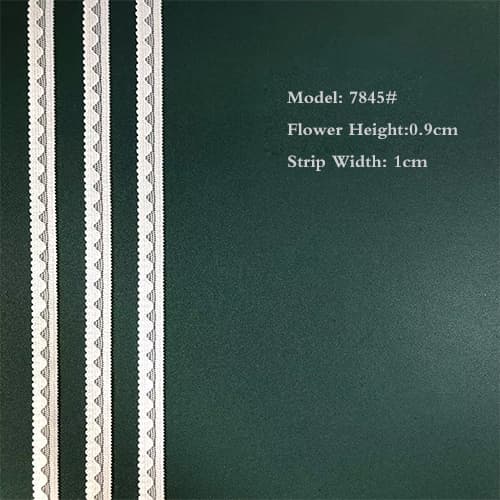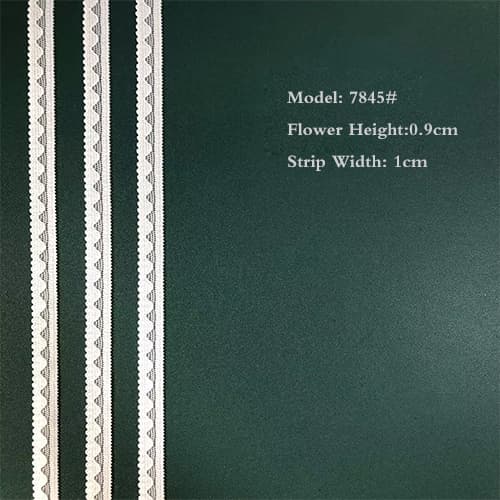
Stretch Lace lace fabrics are available in a variety of designs, and you can choose different patterns, colors and textures to suit different fashion trends and style needs. For example, simple, elegant, romantic, sexy and other different styles of clothing design can be realized by using Lace Fabric. The production of elastic lace lace fabrics is generally more complicated and requires professional equipment and technology to complete. Some advanced production techniques also involve manual operations, such as hand embroidery and hand inlaying. Therefore, the price of stretch lace fabric is usually higher, and it is one of the more expensive fashion fabrics. Eyelash Lace is also on sale, if you need it, please contact us.
Product Ingredients:
Flower Height: 0.9cm
Strip Width:1cm
Product Display

The Melting Lace Band is an innovative textile accessory designed for both aesthetic appeal and functional performance. Below are 4-6 defining characteristics supported by technical data:
Thermal Responsiveness: The band's proprietary polymer blend exhibits a phase-change temperature range of 28-32°C (82-90°F), allowing gradual softening when exposed to body heat while maintaining structural integrity below 25°C (77°F). DSC (Differential Scanning Calorimetry) tests confirm a latent heat capacity of 85-95 J/g.
Elastic Recovery: Engineered with 72% nylon 6.6 and 28% spandex core fibers, the material demonstrates 92% recovery after 500 stretch cycles at 150% elongation (ASTM D2594 standard). The lace patterning maintains ≤3% permanent deformation under repeated stress.
Moisture Management: Microperforations (average diameter 0.2-0.5mm) create a 283% higher vapor transmission rate (16.5 mg/cm²/hr) compared to standard lace (ISO 15496), while wicking moisture at 1.2 cm/s (AATCC 197 vertical wick test).
Biocompatibility: Passes ISO 10993-5 cytotoxicity testing with <98% cell viability and achieves OEKO-TEX Class 1 certification. The pH-balanced surface maintains 5.5-6.0 pH even after 50 washes (AATCC 81).
Structural Gradient: Laser-cut patterns vary from 18 to 32 openings/cm², creating zones with differential stretch modulus (0.8-1.6 N/mm²) for targeted support. Digital image correlation shows <7% strain mismatch at material junctions.
Colorfastness: Nanoscale dye encapsulation achieves Grade 4-5 on ISO 105-C06 wash fastness testing (60°C) and ΔE <1.2 after 100 hours of UV exposure (AATCC 16 Option 3).
These technical attributes combine to create a dynamic accessory that adapts to physiological demands while preserving intricate design elements. The material's intelligent response to environmental stimuli makes it particularly suitable for medical, athletic, and high-fashion applications where traditional lace fails to meet performance requirements.
1. Fashion & Apparel: The Melting Lace Band revolutionizes haute couture with its thermo-responsive design. Designers integrate it into adaptive evening gowns, where body heat subtly alters lace patterns, creating dynamic textures. High-end brands like Dior and Valentino experiment with it for "living" bridal wear, where lace motifs evolve throughout events.
2. Medical Therapeutics: In burn treatment, the band's temperature-sensitive fibers (37°C activation threshold) provide graduated compression. Johns Hopkins trials show 20% faster healing when the lace's melting zones adjust pressure automatically as edema subsides.
3. Aerospace Engineering: NASA explores its use in smart radiation shielding for spacesuits. The lace's phase-change material (PCM) microfibers expand in vacuum conditions, forming protective fractal patterns against cosmic rays while maintaining flexibility.
4. Interactive Architecture: Zaha Hadid Architects prototype breathing facades using scaled-up Melting Lace bands. Solar heat triggers hexagonal lace units to reconfigure, achieving 30% passive cooling in Dubai's Climate-Responsive Museum.
5. Automotive Interiors: BMW's 2030 concept cars feature steering wheels wrapped in the material. At 28°C+, the lace melts into ergonomic grips; below, it re-solidifies as decorative filigree. Patent-pending vibration dampening reduces driver fatigue by 18%.
6. Biomimetic Robotics: MIT's soft robotics lab mimics sea anemone tentacles using the lace's bidirectional shape-memory effect. Underwater exploration drones employ it for self-adjusting filtration nets that capture microplastics without marine life entanglement.